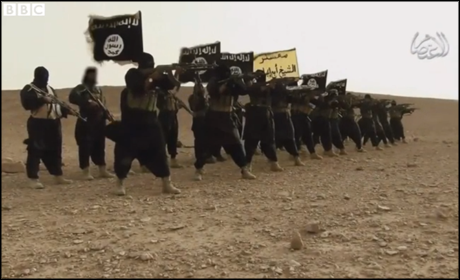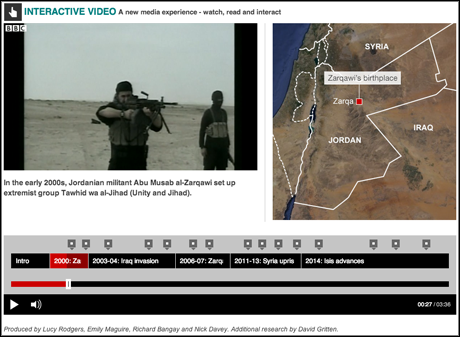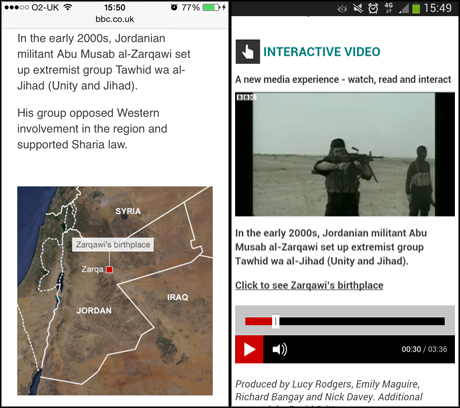
While the world wrings its hands over the situation in Gaza, militant group Islamic State (IS) has stepped up its murderous assault on the people of north-western Iraq.
Previously known as the Islamic State of Iraq and Syria before changing its name to the Islamic State of Iraq and the Levant, IS is said to have 10,000 fighters, $2 billion in funds, and is currently engaged in a campaign of ethnic cleansing against the Yazidi population in the region.
As Barack Obama sanctioned air strikes today to support the Iraqi army in rescuing tens of thousands of Yazidi trapped in the mountains, the BBC has pulled together a portfolio of content from across the organisation to explain the crisis – including a live blog; live stream; assortment of maps and graphics; explainers and eyewitness accounts; and a new form of interactive video.
The interactive – titled 'The rise of the Islamic State' and involving video, interactive graphics, text and a navigable timeline – is the first phase of experimentation in a new form of storytelling, according to visual journalism editor Amanda Farnsworth.The interactive elements – the maps and graphics – are supposed to augment the story that is happening in the core video timelineAmanda Farnsworth, BBC
"When a big story breaks, how can we do something that has real visual impact but turn it around much more quickly than we normally can in an online environment?," Farnsworth told Journalism.co.uk.
"We've got many different answers to this question and this is one of the answers."
The video follows the rise of IS, the disparate jihadist militants that opposed Western forces in Iraq who then joined rebel fighters in Syria, before sweeping across Syria and north-eastern Iraq and declaring the area a caliphate under Sharia law.
At a time when the conflict is gaining more recognition on the international stage, the video aims to explain the rise of IS in a way which none of the individual elements could achieve alone.

Screenshot of 'The rise of the Islamic State' from BBC.co.uk
"The interactive elements – the maps and graphics – are supposed to augment the story that is happening in the core video timeline," said Farnsworth, commending BBC journalist Lucy Rodgers for her role in researching and creating these element. "They are all relevant to what's going on in the video."
On a technical level, interactive developer Richard Bangay said javascript library Popcorn.js had played a major role in how the project was built, acting like a "timeline-based controller" for the different pieces of content.
"It fires events at given times along a timeline," Bangay told Journalism.co.uk. "In our case the most obvious timeline content type we have is the video so you can see the video timeline progressing and at given times along that video we would fire an event and a bit of content would display."
The main challenge, however, was in making the project viewable on different types of devices, especially when there are so many combinations of browsers, devices, and screen sizes available.

Screenshot of the same page from 'The rise of the Islamic State' as displayed on an iPhone 5 (l) and Samsung Galaxy S4 Mini (r)
When a user plays video on an Apple device, for example, the video will open in a different program by default, separating it from the rest of the interactive and losing the context the other features provide.
"We try to detect what content types a browser or device may or may not support and try to provide alternative content," said Bangay of the solution. "That way we can provide as rich an experience as possible to as may people as possible without excluding people needlessly."
This lack of consistency when it comes to displaying on mobile devices is an element the team hope to overcome in future experiments in the same vein, after a review process looking at internal and public feedback on the project.
"It was our first time," said Farnsworth, "so we learned an awful lot of lessons. We called for audience feedback and we're already getting a lot of numbers in.
"Some people really like it, others said we might have tried to pack too much in."
The point though, she said, was in being open about the nature of the experiment and welcoming feedback to understand where the BBC can go in telling large stories on a short timescale in new and innovative ways.
"Another thing we're looking at is a social media solution," she said, "an experiment with a mobile and social-first response to a big, breaking story."
Free daily newsletter
If you like our news and feature articles, you can sign up to receive our free daily (Mon-Fri) email newsletter (mobile friendly).
Related articles
- 200 speakers you need at your next journalism event to avoid all-male panels
- How Reuters, Newsquest and BBC experiment with generative AI
- 38 mojo apps from BBC trainer Marc Blank-Settle
- Standing out in a crowded market: what makes a top news podcast?
- How can UK commercial local news media respond to BBC expansion?









